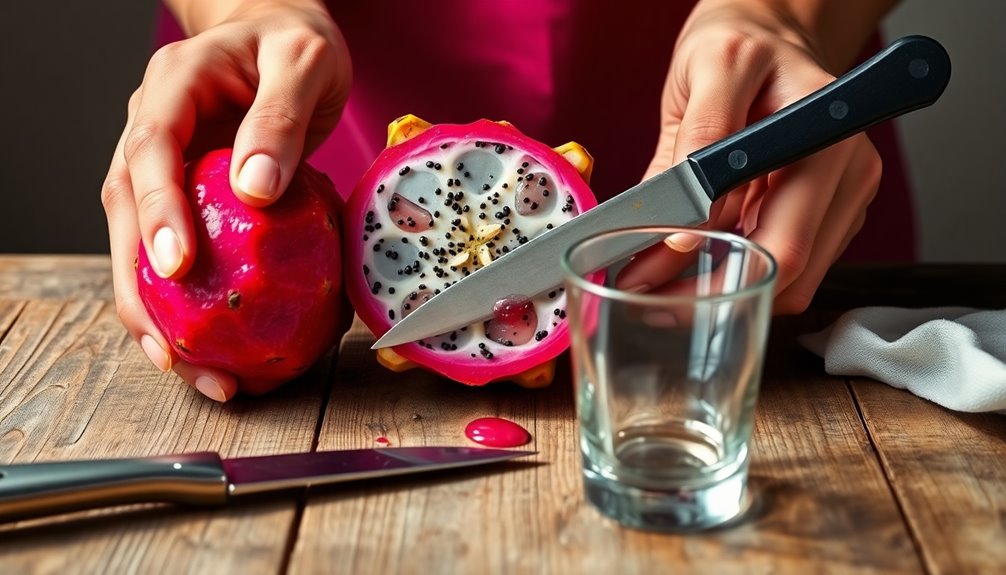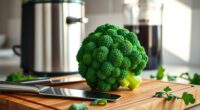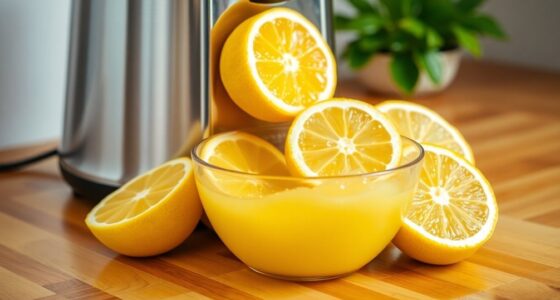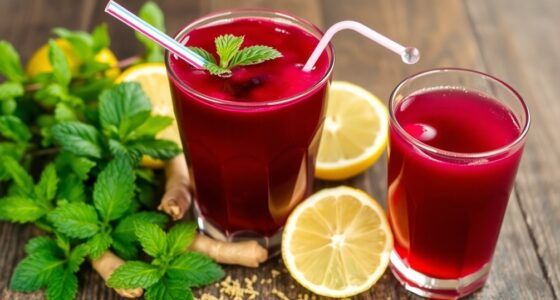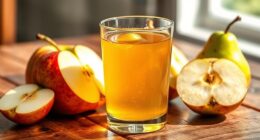To juice a prickly pear, start by safely removing the spines and peeling the fruit. Chop it into pieces and simmer in a pot with a little water for about 20 minutes until it softens. Mash the fruit and strain the mixture to separate the juice from the seeds and pulp. You can enhance the flavor with lime juice and sweeteners like honey. This refreshing juice can be served over ice, and there's more to explore!
Key Takeaways
- Remove spines from the prickly pear using tongs or gloves for safety before handling.
- Slice off both ends and make a shallow cut in the skin to peel the fruit.
- Boil chopped fruit in a pot with a splash of water for about 20 minutes to soften it.
- Mash the softened fruit and strain the mixture to separate juice from seeds and pulp.
- Enhance the flavor with citric acid, lime juice, or sweeteners, adjusting to personal taste.
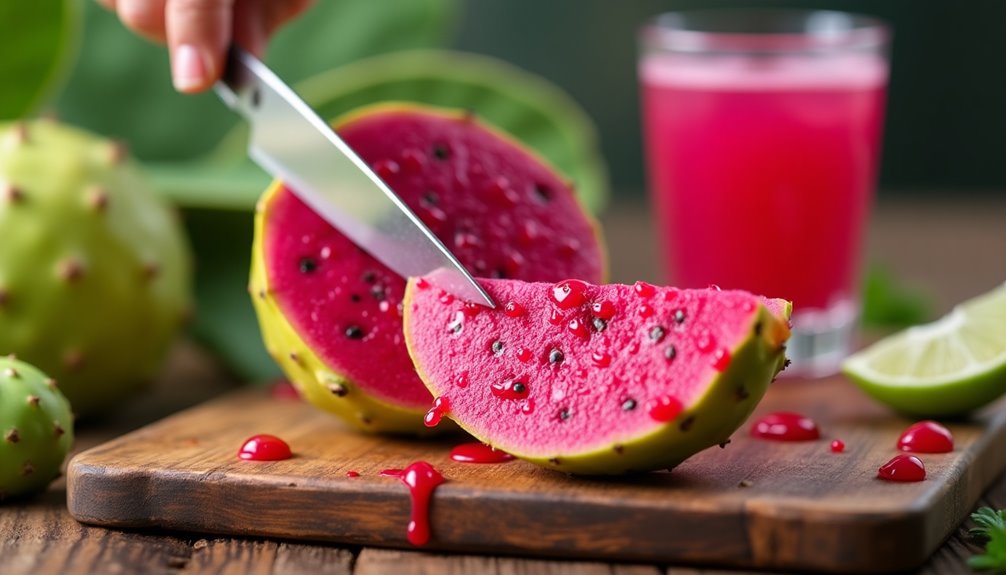
Juicing a prickly pear might seem daunting, but it's a straightforward process that yields delicious results. This vibrant fruit, known for its unique flavor and stunning color, can be transformed into a refreshing juice that's perfect for hot days or as a unique addition to your favorite cocktails. Follow these simple steps, and you'll be enjoying your homemade prickly pear juice in no time.
First things first, you'll need to prepare the prickly pear. Before you even think about juicing, make sure to remove the spines. These tiny, hair-like spines can be quite prickly, so it's best to use tongs or wear gloves for safety. After that, slice off both ends of the fruit. This will make it easier to peel.
Now, make a shallow cut lengthwise in the skin; this will help you peel it away cleanly. Gently remove the skin to reveal the soft, juicy flesh inside. Once you've done that, chop the peeled prickly pear fruit into smaller pieces. This will help with the juicing process later on.
Next, place the fruit in a pot and cover it with just enough water to prevent sticking. You don't want to drown the fruit; just a splash will do. Bring it to a boil and let it simmer for about 20 minutes. During this time, the fruit will soften and release its juices.
After boiling, take a potato masher and mash the fruit in the pot. This step is crucial as it helps extract more juice from the fruit.
Once you've mashed the prickly pear, it's time to strain the mixture. Use a fine mesh sieve to separate the juice from the seeds and pulp. You can use the back of a spoon to press the mixture, ensuring you get every drop of juice out. If you find that the juice is a bit thick for your liking, feel free to add a little more water to thin it out.
Now that you have your freshly extracted juice, it's time to enhance the flavor. You can add citric acid or a squeeze of lime juice to taste, which will brighten the flavors beautifully. If you prefer a sweeter juice, consider adding sweeteners like sugar or honey. Stir until everything is well combined.
Finally, serve your prickly pear juice over ice for a refreshing treat. This vibrant drink not only looks beautiful but tastes incredible, too. Whether you enjoy it on its own or mix it into a cocktail, you'll be glad you took the time to juice this unique fruit. Enjoy the process, and don't hesitate to experiment with flavors; after all, that's part of the fun!
Frequently Asked Questions
How to Get Juice Out of Prickly Pear?
To get juice out of prickly pear, you'll need to start by carefully removing the spines.
Cut off both ends of the fruit and slice the skin to peel it away.
Chop the flesh into smaller pieces and place them in a pot with just enough water to cover them.
Boil for about 20 minutes, then mash the fruit to release the juice.
Finally, strain the mixture to separate the liquid from the solids.
Is Prickly Pear Juice Safe to Drink?
Imagine sipping a vibrant, ruby-red elixir that dances on your taste buds. Yes, prickly pear juice is generally safe to drink and packs a punch of vitamins A and C while being low in calories.
However, if you're new to it, start with a small amount to see how your body reacts, as some folks might experience mild digestive issues.
If you're pregnant or breastfeeding, it's best to chat with your doctor first.
How to Get Juice From Cactus?
To get juice from a cactus, start by safely removing any spines using tongs or a torch.
Once you've prepared the cactus, slice it open to expose the flesh.
Chop it into small pieces and place them in a pot with a bit of water.
Boil it for about 20 minutes, then mash the softened fruit and strain the mixture through a fine sieve to separate the juice from the pulp.
Enjoy your fresh cactus juice!
How Do You Clean a Prickly Pear Cactus Fruit?
Cleaning a prickly pear is like preparing a treasure for a feast. First, soak the fruit in water to wash away the grime.
Then grab some metal tongs or thick gloves—these little guys can bite back! Trim off both ends and make a shallow cut down the side.
Peel off the skin carefully, avoiding any sneaky spines. Finally, rinse it under running water to ensure it's ready for your culinary adventure!
Conclusion
Juicing a prickly pear transforms its vibrant, spiky exterior into a smooth, refreshing beverage. Just as the cactus thrives in harsh conditions, you too can extract something beautiful from life's challenges. With each sip, you savor the sweet, unique flavor that contrasts sharply with the fruit's intimidating appearance. So, embrace the process—each step reveals the hidden treasures within. Whether you enjoy it solo or mix it into a cocktail, you're celebrating nature's ability to surprise us.
Cindy thoroughly researches juicing trends, techniques, and recipes to provide readers with practical advice and inspiration. Her writing style is accessible, engaging, and designed to make complex concepts easy to understand. Cindy’s dedication to promoting the advantages of juicing shines through her work, empowering readers to make positive changes in their lives through the simple act of juicing.

